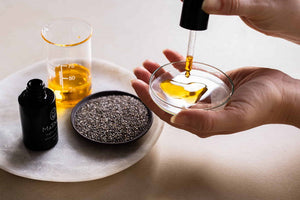Natural plant oils have been used for centuries. Around the globe, women care for their skin and hair with locally produced plant oils. And some of the most incredible skin secrets are a part of some nations' heritage. Did you know that women in Africa use shea butter to nourish their children's skin, that camellia oil is a well-kept secret in Japan, that women in Morocco who make argan oil by hand have such beautiful skin? Do you know the code in the chemistry of plant oils that makes them work with your skin? You don't have to be a chemist to understand the main ingredients, fatty acids and what works best for you.
The skin barrier and oil compatibility?

At the beginning of my natural skincare journey, plant oil was just a greasy liquid. I was part of the oil-free generation that avoided oils of any kind because of the fear of excessive oiliness on the surface of my skin.
The "aha" moment for me was understanding the biology of the skin surface. Did you know that the top layer of the epidermis, the stratum corneum, when it is healthy, retains enough water and acts as a hydrolipidic film to function as the first line of defence against the outside world? Moisture balance is essential for maintaining the protective function and flexibility of the skin. The precise organization of the stratum corneum relies on the complex arrangement of corneocytes, natural moisturizing factors (NMFs), and an appropriate level and ratio of intercellular lipids that form a "brick-and-mortar'-like" barrier.
What does this mean - it means before going more deeply that natural plant oils are so compatible with skin biology.
Natural plant oils properties: from inflammation to severe dryness
Many natural oils possess specific compounds with antimicrobial, antioxidant, anti-inflammatory, and anti-ageing properties, making them great alternative and complementary treatments for many skin conditions - from inflammatory conditions connected with skin barrier dysfunction to skin conditions associated with skin ageing.
The unique properties of different oils are essential when understanding their use in skincare. There is a whole new world to explore in deeper understanding the chemistry behind plant oils - but important is to know that some key components of plant oils, different ratios of essential fatty acids or some other matter will determine the potential and benefits of natural plant oils.
Natural plant oils: source of plant superfood in tiny seed or kernels

Plants store energy in their seeds and kernels, which they need to germinate and grow. In photosynthesis, plants form sugars in their leaves from the water, carbon dioxide, and light. This creates glycerol and fatty acids in a multi-stage conversion process, combining to form oils and fats stored in the seeds or kernels. Even more impressive is that the plant world can feed itself through this process. And this without any outside influence!
Natural plant oils: let’s study some chemistry
Oils are compounds that consist mainly of glycerides formed from a reduction reaction between fatty acids and glycerol. Unlike animal fats, except for fish oils, most vegetable oils are liquid at room temperature. Most plant-based oils are low in saturated fats and high in polyunsaturated and monounsaturated fats. One of the commonly known exceptions is coconut oil, semi-solid at room temperature and high in saturated fats.
Nature is ingenious; there are many different types of oils, each with unique properties, not two are the same.
Plant-based oils are composed of different proportions of monounsaturated (MUFAs), polyunsaturated (PUFAs), and saturated fatty acids (SFAs). In addition, different oils have different compositions of fatty acids with different chain lengths and degrees of saturation. The length of their carbon backbones indicates the chain lengths of fatty acids. For example, a short-chain fatty acid has six or fewer carbons in its backbone (C6:0), medium-chain fatty acids have B12 carbons (C12:0), and long-chain fatty acids have 12-22 carbons. Different oils also contain different amounts of omega-3 and omega-6 fatty acids. Additional structural differences between oils include unique side chains and degree of saturation. Certain natural oils are unstable and can be degraded and oxidised, producing irritating chemicals that can lead to spoilage or microbial growth. Therefore, the different characteristics of oils emphasise the importance of thoughtful selection for skin moisturisation.
My fascination with the uniqueness of chemistry of plant oils was the first and the primary motivation to create a product that will provide the skin with emollience, act anti-inflammatory and antiaging and restore skin's barrier. This is how re.glow oil serum was born.
What is important to know when choosing plant oils?

Certain natural, cold-pressed plant oils possess antioxidant, antimicrobial, and skin barrier repair properties, making them promising skincare products for inflammatory skin conditions associated with barrier disruption. However, natural plant oils have very different effects when applied to the skin; therefore, it is better to understand their unique properties and optimal extraction processes.
Natural plant oils with a higher linoleic acid content, such as grapeseed oil or watermelon seed oil, may benefit the skin barrier. In contrast, oils with a higher oleic acid content, such as olive oil, may be harmful to the skin barrier.
Oils with a higher linoleic acid to oleic acid ratio are always the better choice for barrier repair. The oils in this family are grapeseed oil, watermelon seed oil, passionfruit oil, and this is the exact reason we have included them in our re.start cleansing oil formula - to perform inflammatory and repair the skin barrier.
In contrast, oils with higher amounts of irritating oleic acid may compromise skin barrier function. But this is not the reason to exclude them from skincare products. On the contrary, they work great for dry skin. It is essential to balance oleic rich oils with other oils to provide overall care for the skin.
Why you should add plant oils to your skincare routine?
Give you plump and radiant skin
Fatty acids from natural plant oils provide nutrients, even out overall skin tone, and help skin retain moisture, resulting in smooth, plump, glowing skin!
Essential fatty acids are those that our bodies cannot synthesize but can only be obtained through our diet and application to our skin. Some great options with unique natural essential fatty acid richness are rosehip oil, chia seed oil, argan oil, sea buckthorn oil and, very uniquely, pomegranate oil.
Great for acne and skin with imperfections
Oily skin and skin that tends to have clogged pores is skin that lacks linoleic acid. As mentioned earlier, this fatty acid is found in some plant oils like grapeseed oil or watermelon seed oil. Contrary to popular belief, using natural plant oils rich in linoleic acid can help reduce blackheads and pimples. In one study, black seed oil was found to reduce acne after 2 months of use. This shows how plant oils can help unclog pores and reduce acne too!
Some plant oils have healing properties that can kill acne-causing bacteria and reduce inflammation. In the case of jojoba oil, research showed a calming effect on mild acne.
Natural plant oils are super antioxidative

Not only are plant oils great for moisturising and nourishing your skin, but they are also great for giving your skin the extra protection it needs.
Being rich in fat-soluble vitamins and antioxidants, such as vitamins A and E, are some of the ultimate skin-regenerating ingredients. These vitamins and antioxidants are a shield from free radicals. Free radicals are molecules that damage your skin cells. They come from the environment and the sun's ultraviolet (UV) rays, which cause unwanted wrinkles. I am a great believer in skin empowerment, and plant oils rich in antioxidants are the best natural resource for free radical’s protection.
Plus, the fatty acids in vegetable oils have anti-inflammatory properties, making them exceptional for treating skin conditions like eczema and rosacea. Consistency is key, as regular use of plant oils improves fine lines, brightens skin, and neutralises scars.
Balance both oily and dry skin
If you feel like your skin is varying from the normal, shifting between dry and oily, it's a sign that oil production is not balanced. Sometimes the best way to balance excess oil is to add more oil. And that's precisely where natural plant oils can help!
Sebum is an oily and waxy substance produced in the top layer of our skin that helps to protect and hydrate it. It is made up of ceramides, fatty acids and cholesterol - and all of these components are found in plant oils.
Jojoba oil and argan oil have properties that regulate sebum so well that they trick your skin into thinking it produced it itself. Research has shown that argan oil, applied twice a day, helps to reduce the oiliness of the skin. Not only are plant oils gentle and effective, they also help restore the balance of natural oils already on your skin!
Let me sum it up
So, are plant oils a remedy for every skin type? I firmly believe that yes, but before you begin your plant oil adventure, consider the complexity of the natural compound in each plant oil.
Suppose you do not know where to start. In that case, you can choose thoughtfully created oil serums that contain a balanced composition of oils in terms of fatty acid profile, the optimal ratio of omegas and proportional penetration rate. Although it seems very easy, creating such oils serum is a sort of artisanal process with a deep understanding of plant oil chemistry and skin biology. Re.glow oil serum is designed that way.
The application of plant oils can have different effects depending on the composition and skin condition. Composition varies due to different extraction methods, so my advice is always to reach cold-pressed organic oils. Remember that the components of plant oils (triglycerides, phospholipids, fatty acids, phenolic compounds and antioxidants) can act synergistically through several mechanisms:
- promotion of skin barrier homeostasis,
- antioxidant activities,
- anti-inflammatory properties,
- antimicrobial properties,
- promotion of wound healing.
Although we have been using oils for centuries and we still retain some of our grandmothers' plant oil secrets of how to care for our skin or keep our hair shiny, I believe that future scientific work will go further to provide an even better understanding of these oils and the complexity of these natural remedies.
With love, Ivanka

